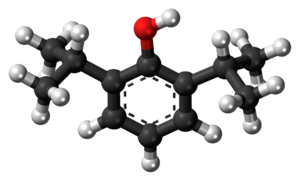Propofol
| Propofol | |
 | |
 | |
| Identificare | |
|---|---|
| Număr CAS | 2078-54-8[1][2] |
| PubChem | 4943[3] |
| DrugBank | DB00818 |
| ChemSpider | 4774[4] |
| UNII | YI7VU623SF[1] |
| KEGG | D00549[5] |
| ChEMBL | CHEMBL526[6] |
| Cod ATC | N01AX10[7] |
| SMILES | CC(C)C1=C(C(=CC=C1)C(C)C)O[3] |
| InChI | InChI=InChI=1S/C12H18O/c1-8(2)10-6-5-7-11(9(3)4)12(10)13/h5-9,13H,1-4H3[3] |
| Date chimice | |
| Formulă | C₁₂H₁₈O[3] |
| Masă molară | 178,136 u.a.m.[8] |
| Date fizice | |
| Densitate | 0,955 g/cm³[9] |
| Punct de topire | 18 °C[10][9] |
| Punct de fierbere | 247 °C[9] |
| Modifică date / text | |
Propofolul este un medicament sedativ-hipnotic utilizat pentru inducerea anesteziei generale.[11][12][13] Calea de administrare disponibilă este cea intravenoasă.[11]
Molecula a fost patentată în 1977 și a fost aprobată pentru uz medical în Statele Unite ale Americii în anul 1989.[11][14] Se află pe lista medicamentelor esențiale ale Organizației Mondiale a Sănătății.[15] Este disponibil sub formă de medicament generic.[11]
Utilizări medicale
[modificare | modificare sursă]Propofolul este folosit pe larg și a înlocuit tiopentalul, fiind agent de elecție pentru sedare, producând o senzație de euforie iar după anestezie nu induce stări de greață și vărsături.[16] Nu are efecte analgezice, așadar poate fi utilizat în asociere cu opioide, precum morfina.[16]
Reacții adverse
[modificare | modificare sursă]Propofolul poate induce aritmii cardiace, hipotensiune arterială și apnee tranzitorie.[11]
Farmacologie
[modificare | modificare sursă]Se pare că propofolul prezintă mai multe mecanisme de acțiune farmacologică,[17][18][19] majoritatea prin potențarea activității inhibitoare mediate de acidul gama-aminobutiric, fiind un modulator alosteric pozitiv al receptorului GABAA. Încetinește timpul de închidere al canalelor de clor și poate să activeze receptorii chiar și în lipsa GABA, prezentând și un efect agonist pe receptorul GABAA.[20][21][22] S-a demonstrat că unii analogi de propofol funcționează ca blocante ale canalelor de calciu.[23][24]
Note
[modificare | modificare sursă]- ^ a b c d propofol (în engleză), Global Substance Registration System, accesat în
- ^ a b CAS Common Chemistry, accesat în
- ^ a b c d e f g h i j k l „Propofol”, propofol (în engleză), PubChem, accesat în
- ^ a b Propofol (în engleză), ChemSpider, accesat în
- ^ a b propofol (în engleză), ChEBI, accesat în
- ^ a b PROPOFOL (în engleză), ChEMBL, accesat în
- ^ a b Propofol (în engleză), DrugBank,
- ^ a b „Propofol”, propofol (în engleză), PubChem, accesat în
- ^ a b c d e f CRC Handbook of Chemistry and Physics (97th edition)[*], p. 3-468 Verificați valoarea
|titlelink=(ajutor) - ^ a b Jean-Claude Bradley Open Melting Point Dataset
- ^ a b c d e „Propofol”. The American Society of Health-System Pharmacists. Accesat în .
- ^ „Propofol”. DrugBank - Canadian Institutes of Health Research. Accesat în .
- ^ „Rezumatul caracteristicilor produsului - Propofol Pfizer 10 mg/ml emulsie injectabilă/perfuzabilă” (PDF). Agenția Națională a Medicamentului și a Dispozitivelor Medicale din România. Arhivat din original (PDF) la . Accesat în . Parametru necunoscut
|arhivat=ignorat (ajutor); Mai multe valori specificate pentru|urlarhivă=și|archive-url=(ajutor); Mai multe valori specificate pentru|deadurl=și|dead-url=(ajutor) - ^ Miller's Anesthesia (ed. 8). Elsevier Health Sciences. . p. 920. ISBN 9780323280112.
- ^ Organizația Mondială a Sănătății (). World Health Organization model list of essential medicines: 21st list 2019 (PDF) (în engleză). Geneva: World Health Organization. hdl:10665/325771
 . WHO/MVP/EMP/IAU/2019.06. License: CC BY-NC-SA 3.0 IGO.
. WHO/MVP/EMP/IAU/2019.06. License: CC BY-NC-SA 3.0 IGO.
- ^ a b Miner, JR; Burton, JH (august 2007). „Clinical practice advisory: Emergency department procedural sedation with propofol”. Annals of Emergency Medicine. 50 (2): 182–7. doi:10.1016/j.annemergmed.2006.12.017. PMID 17321006.
- ^ Trapani G, Altomare C, Liso G, Sanna E, Biggio G (februarie 2000). „Propofol in anesthesia. Mechanism of action, structure-activity relationships, and drug delivery”. Curr. Med. Chem. 7 (2): 249–71. doi:10.2174/0929867003375335. PMID 10637364.
- ^ Kotani, Y; Shimazawa, M; Yoshimura, S; Iwama, T; Hara, H (). „The experimental and clinical pharmacology of propofol, an anesthetic agent with neuroprotective properties”. CNS Neuroscience and Therapeutics. 14 (2): 95–106. doi:10.1111/j.1527-3458.2008.00043.x. PMC 6494023
 . PMID 18482023.
. PMID 18482023.
- ^ Vanlersberghe, C; Camu, F (). Propofol. Handbook of Experimental Pharmacology. 182. pp. 227–52. doi:10.1007/978-3-540-74806-9_11. ISBN 978-3-540-72813-9. PMID 18175094.
- ^ Trapani, G; Latrofa, A; Franco, M; Altomare, C; Sanna, E; Usala, M; Biggio, G; Liso, G (). „Propofol analogues. Synthesis, relationships between structure and affinity at GABAA receptor in rat brain, and differential electrophysiological profile at recombinant human GABAA receptors”. Journal of Medicinal Chemistry. 41 (11): 1846–54. doi:10.1021/jm970681h. PMID 9599235.
- ^ Krasowski MD, Jenkins A, Flood P, Kung AY, Hopfinger AJ, Harrison NL (aprilie 2001). „General anesthetic potencies of a series of propofol analogs correlate with potency for potentiation of gamma-aminobutyric acid (GABA) current at the GABA(A) receptor but not with lipid solubility”. J. Pharmacol. Exp. Ther. 297 (1): 338–51. PMID 11259561.
- ^ Krasowski, MD; Hong, X; Hopfinger, AJ; Harrison, NL (). „4D-QSAR analysis of a set of propofol analogues: mapping binding sites for an anesthetic phenol on the GABA(A) receptor”. Journal of Medicinal Chemistry. 45 (15): 3210–21. doi:10.1021/jm010461a. PMC 2864546
 . PMID 12109905.
. PMID 12109905.
- ^ Haeseler G, Leuwer M (martie 2003). „High-affinity block of voltage-operated rat IIA neuronal sodium channels by 2,6 di-tert-butylphenol, a propofol analogue”. Eur J Anaesthesiol. 20 (3): 220–4. doi:10.1017/s0265021503000371. PMID 12650493.
- ^ Haeseler, G; Karst, M; Foadi, N; Gudehus, S; Roeder, A; Hecker, H; Dengler, R; Leuwer, M (septembrie 2008). „High-affinity blockade of voltage-operated skeletal muscle and neuronal sodium channels by halogenated propofol analogues”. British Journal of Pharmacology. 155 (2): 265–75. doi:10.1038/bjp.2008.255. PMC 2538694
 . PMID 18574460.
. PMID 18574460.
Vezi și
[modificare | modificare sursă]
| |||||||||||||||||||
Text is available under the CC BY-SA 4.0 license; additional terms may apply.
Images, videos and audio are available under their respective licenses.
